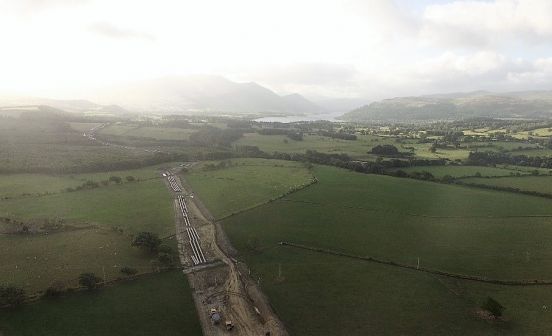One of England’s largest water pipeline schemes is carving its way across the Cumbrian landscape, to enable a new water supply to feed the West Coast of Cumbria. The project is understood to be affecting approximately 375 farmers/landowners with work in progress easy to spot from main roads in the area and from the top of Skiddaw.
The United Utilities West Cumbria Water Supply Project started in 2014 and is expected to last until at least 2022. It will create a 30 kilometre aqueduct carrying water from Thirlmere across to West Cumbria and a new treatment works being constructed near Redmain, which will treat 80 million litres of water a day when completed in 2022. A new mains water line will carry treated water along to Quarry Hill near Wigton and Summergrove, Whitehaven. Refurbishment of existing water pipes is also being carried out between Stainburn, Workington and near Loweswater.
The ambitious scheme crosses swathes of agricultural land and required consultation with those affected. Whilst the pipeline must travel across farmland, compromises have been made along the way to reduce the impact as much as possible for those affected and compensation is tailored to individual needs.
The course of the pipeline has evolved from three potential options at the start, making adaptations that include a tunnel at Castlerigg and adjustments that enable businesses to operate more effectively.
Some of the key issues faced by landowners and farmers include the effect on existing Environmental Agreements and Basic Payment Subsidies. And with the prolonged dry weather, the temporary loss of land for grazing or cropping has caused additional pressures.
Landowners also report that an ongoing concern is the issue of access to their land, the quality of fencing and the risk of gates being left open and livestock straying.
Chris Edmunds, a Chartered Surveyor and Land Agent with Davidson & Robertson (D&R) in Cockermouth is working with dozens of farmers and landowners across the pipeline project, all at different stages. Chris said “D&R has over 120 years’ experience working on utility projects including gas and oil pipelines dating back to the 1970’s. This scheme is currently one of the biggest water pipe projects in England and has wide reaching impacts which are different for every farmer and landowner United Utilities have taken a case by case approach on different business’ whilst working within the statutory framework.
Calling us in at early stages
“We spent a great deal of time talking to local farmers when the consultation process began and now act for many of them to ensure disruption is kept to a minimum and that any issues are resolved as swiftly as possible. In some instances, the pipeline route was adjusted to reduce the impact on businesses.
“Sometimes we are brought in too late and can’t assist with access and route changes along with accommodation works, but on the pipeline project, being proactive at the start has made a real difference.
“It is a very stressful time, farmers and landowners are concerned about protecting the landscape as well as their income and there is a lot of additional paperwork for subsidies, inconvenience for moving stock, disturbance and crop losses – which this year, with the prolonged heat, has brought additional issues.
“We have been involved with a number of force majeure notifications for clients with respect to Natural England taking land temporality out of environmental agreements and we’re also being asked to help clients notify the Rural Payments Agency about land that is temporarily unavailable to claim in the Basic Payment Scheme. Environmental schemes and BPS support is a growing area for us.”
Areas of trees and woodland are also affected as the pipe line cuts through the habitats. Iain Kyle Forestry Manager for Davidson & Robertson has been assessing tree losses and replanting proposals as part of their support to clients.
Cattle crossing
The original pipeline route would have cut across one of our client’s land having dramatic effect on the farm, with one third of land the other side of the line, required for dairy cow grazing.
The success of the project will only be proved in 5-10 years’ time when we see how well the land has recovered. UU aims to leave as they find, but it’s not as simple as that and some things can’t be replaced so easily – like 300 year old oak trees.
Many people will monitor the scar on the landscape visible from Skiddaw – but that should fade with time as the landscape recovers.
This is just one example of one of the Projects we are currently involved with across the firm, please contact your local office should you need assistance with any utility project.



